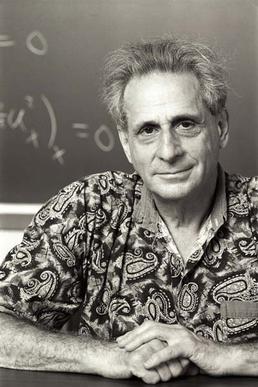Integrable algorithms are numerical algorithms that rely on basic ideas from the mathematical theory of integrable systems. [1]
Integrable algorithms are numerical algorithms that rely on basic ideas from the mathematical theory of integrable systems. [1]
The theory of integrable systems has advanced with the connection between numerical analysis. For example, the discovery of solitons came from the numerical experiments to the KdV equation by Norman Zabusky and Martin David Kruskal. [2] Today, various relations between numerical analysis and integrable systems have been found (Toda lattice and numerical linear algebra, [3] [4] discrete soliton equations and series acceleration [5] [6] ), and studies to apply integrable systems to numerical computation are rapidly advancing. [7] [8]
Generally, it is hard to accurately compute the solutions of nonlinear differential equations due to its non-linearity. In order to overcome this difficulty, R. Hirota has made discrete versions of integrable systems with the viewpoint of "Preserve mathematical structures of integrable systems in the discrete versions". [9] [10] [11] [12] [13]
At the same time, Mark J. Ablowitz and others have not only made discrete soliton equations with discrete Lax pair but also compared numerical results between integrable difference schemes and ordinary methods. [14] [15] [16] [17] [18] As a result of their experiments, they have found that the accuracy can be improved with integrable difference schemes at some cases. [19] [20] [21] [22]

Martin David Kruskal was an American mathematician and physicist. He made fundamental contributions in many areas of mathematics and science, ranging from plasma physics to general relativity and from nonlinear analysis to asymptotic analysis. His most celebrated contribution was in the theory of solitons.
The Green–Kubo relations give the exact mathematical expression for a transport coefficients in terms of the integral of the equilibrium time correlation function of the time derivative of a corresponding microscopic variable :

In physics, a breather is a nonlinear wave in which energy concentrates in a localized and oscillatory fashion. This contradicts with the expectations derived from the corresponding linear system for infinitesimal amplitudes, which tends towards an even distribution of initially localized energy.
In mathematics, integrability is a property of certain dynamical systems. While there are several distinct formal definitions, informally speaking, an integrable system is a dynamical system with sufficiently many conserved quantities, or first integrals that its motion is confined to a submanifold of much smaller dimensionality than that of its phase space.

Computational electromagnetics (CEM), computational electrodynamics or electromagnetic modeling is the process of modeling the interaction of electromagnetic fields with physical objects and the environment using computers.

In mathematics and physics, the Kadomtsev–Petviashvili equation is a partial differential equation to describe nonlinear wave motion. Named after Boris Borisovich Kadomtsev and Vladimir Iosifovich Petviashvili, the KP equation is usually written as
In mathematics, the inverse scattering transform is a method for solving some non-linear partial differential equations. The method is a non-linear analogue, and in some sense generalization, of the Fourier transform, which itself is applied to solve many linear partial differential equations. The name "inverse scattering method" comes from the key idea of recovering the time evolution of a potential from the time evolution of its scattering data: inverse scattering refers to the problem of recovering a potential from its scattering matrix, as opposed to the direct scattering problem of finding the scattering matrix from the potential.
Dissipative solitons (DSs) are stable solitary localized structures that arise in nonlinear spatially extended dissipative systems due to mechanisms of self-organization. They can be considered as an extension of the classical soliton concept in conservative systems. An alternative terminology includes autosolitons, spots and pulses.
In mathematics, the Benjamin–Ono equation is a nonlinear partial integro-differential equation that describes one-dimensional internal waves in deep water. It was introduced by Benjamin (1967) and Ono (1975).

In fluid dynamics, the Camassa–Holm equation is the integrable, dimensionless and non-linear partial differential equation
In the theory of integrable systems, a compacton, introduced in, is a soliton with compact support.
Mark Jay Ablowitz is a professor in the department of Applied Mathematics at the University of Colorado at Boulder, Colorado. He was born in New York City.
Manganese(II) telluride is an inorganic compound with the chemical formula MnTe.
The Hirota–Satsuma equation is a set of three coupled nonlinear partial differential equations:

Roberto Morandotti is a physicist and full Professor, working in the Energy Materials Telecommunications Department of the Institut National de la Recherche Scientifique. The work of his team includes the areas of integrated and quantum photonics, nonlinear and singular optics, as well as terahertz photonics.
The Kundu equation is a general form of integrable system that is gauge-equivalent to the mixed nonlinear Schrödinger equation. It was proposed by Anjan Kundu as
Weizhu Bao is a Chinese mathematician at the National University of Singapore (NUS). He is known for his work in applied mathematics with applications in quantum physics and chemistry and materials science, especially Bose-Einstein condensation (BEC) and highly oscillatory partial differential equations.

Hidetoshi Katori, is a Japanese physicist and professor at the University of Tokyo best known for having invented the magic wavelength technique for ultra precise optical lattice atomic clocks. Since 2011, Katori is also Chief Scientist at the Quantum Metrology Lab, RIKEN.

Akira Hasegawa is a Japanese theoretical physicist and engineer who has worked in the U.S. and Japan. He is known for his work in the derivation of the Hasegawa–Mima equation, which describes fundamental plasma turbulence and the consequent generation of zonal flow that controls plasma diffusion. Hasegawa also made the discovery of optical solitons in glass fibers, a concept that is essential for high speed optical communications.
Tau functions are an important ingredient in the modern mathematical theory of integrable systems, and have numerous applications in a variety of other domains. They were originally introduced by Ryogo Hirota in his direct method approach to soliton equations, based on expressing them in an equivalent bilinear form.